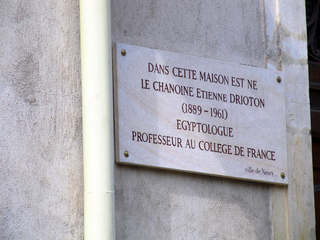
Nag Hammadi is a city and markaz in Upper Egypt. It is located on the west bank of the Nile in the Qena Governorate, about 80 kilometres (50 mi) north-west of Luxor. The city had a population of close to 61,737 as of 2023.

The Nag Hammadi library is a collection of early Christian and Gnostic texts discovered near the Upper Egyptian town of Nag Hammadi in 1945.

Coptology is the scientific study of the Coptic people.

St. Mark's Coptic Orthodox Cathedral is a Coptic church located in the Abbassia District in Cairo, Egypt. The cathedral is the Seat of the Coptic Orthodox Pope. It was built during the time when Pope Cyril VI of Alexandria was Pope of the Coptic Orthodox Church, and was consecrated on 25 June 1968.

Samannud is a city (markaz) located in Gharbia Governorate, Egypt. Known in classical antiquity as Sebennytos, Samannud is a historic city that has been inhabited since the Ancient Egyptian period. As of 2019, the population of the markaz of Samannud was estimated to be 410,388, with 83,417 people living in urban areas and 326,971 in rural areas.
Monastic settlements are areas built up in and around the development of monasteries with the spread of Christianity. To understand Christian monastic settlements, we must understand a brief history of Christian monasticism. Monasticism was a movement especially associated with Early Christianity that began in the late 3rd century to the 4th century in Egypt when early Christians realizing that martyrdom wasn’t much of an option when the Roman empire relaxed Christian persecutions. It was begun by key monks who were known then as “The Desert Fathers” and later, there were female monasteries run by women who later came to be known as “The Desert Mothers”. The most famous Desert Father was Abba Anthony and the most famous Desert Mother was Amma Syncletica.ost of the Christians took to the deserts and arid areas to deny themselves of the social environments and people in order to focus on God and prayer. They denied themselves of a comfortable life often resorting to eating what grew in the deserts as well as living frugally and in poverty. With time, monasticism came to impact the church and even the papacy and there came about two variants of monasticism: The Eastern Monastic movement and the Western Monastic movement. Inspired by the Eastern monastic movements, new monastic movements sprung up in western Europe after the Roman empire fell apart and newer kingdoms like the Franks, Britannia and Germanic tribes sprung up. The papacy was at its infancy and places like the Isles of Britannia had monks that established monasteries along its coastlines. One of the forerunners was St. Augustine whose Rule became encoded in the future doctrine of the Roman clergy of the church.

There have been many architectural styles used in Egyptian buildings over the centuries, including Ancient Egyptian architecture, Greco-Roman architecture, Islamic architecture, and modern architecture.

Old Cairo is a historic area in Cairo, Egypt, which includes the site of a Roman-era fortress, the Christian settlement of Coptic Cairo, and the Muslim-era settlements pre-dating the founding of Cairo proper in 969 AD. It is part of what is referred to as Historic Cairo, a UNESCO World Heritage Site.

The Monastery of Saint Anthony is a Coptic Orthodox monastery standing in an oasis in the Eastern Desert of Egypt, in the northern part of the Red Sea Governorate close to the border with the Suez Governorate.

Babylon Fortress is an Ancient Roman fortress on the eastern bank of the Nile Delta, located in the area known today as Old Cairo or Coptic Cairo. The fortress was built circa 300 AD by Emperor Diocletian in order to protect the entrance to an ancient canal, previously rebuilt by Trajan, that linked the Nile with the Red Sea.

Coptic Cairo is a part of Old Cairo which encompasses the Babylon Fortress, the Coptic Museum, the Hanging Church, the Greek Church of St. George and many other Coptic churches and historical sites. It is believed in Christian tradition that the Holy Family visited this area and stayed at the site of Saints Sergius and Bacchus Church. Coptic Cairo was a stronghold for Christianity in Egypt both before and during the Islamic era, as most of its churches were built after the Muslim conquest of Egypt in the 7th century.

Étienne Marie Felix Drioton was a French Egyptologist, archaeologist, and Catholic canon. He was born in Nancy and died in Montgeron.
Dr. Gawdat Gabra is a Coptologist; he finished his bachelor's degree in Egyptian Antiquities – Cairo University 1967 and PhD in Coptic Antiquities University of Münster – Germany 1978. He studied in the Institute of Egyptology of the Charles University in Prague, too.

Pahor Labib was Director of the Coptic Museum, Cairo, Egypt, from 1951 to 1965 and one of the world leaders in Egyptology and Coptology.
The Monastery of Saint Ammonius, also known as the Monastery of the Martyrs, is a Coptic Orthodox monastery near Esna.

Abbassia is a neighbourhood that makes up five shiakhas in al-Wayli district in Cairo, Egypt.

Bawit is an archaeological site located 80 kilometres (50 mi) north of Asyut, near the village of Dashlout, in Egypt. It covers an area of 40 hectares, and houses a cemetery and the ruins of the Hermopolite monastery of Apa Apollo founded by Apollo in the late fourth century. The structures on this site are relatively well preserved, and demonstrate different aspects of a monastic complex of Middle Egypt.

Marcus Simaika (1864–1944) was an Egyptian leader, politician, and founder of the Coptic Museum in Cairo.
Pbow was a cenobitic monastery established by St. Pachomius in 336-337 AD. Pbow is about 100 km (62 mi) north of Luxor in modern Upper Egypt.
Zuzana Skálová is a Czech historian of medieval art, restorer and teacher of restoring of Coptic icons, who was settled and active from 1989 till 1996 in Egypt. She restored and taught restoring of Coptic icons in Cairo and restored Coptic icons in the Monastery of St. Catherine in Sinai, and others.

















